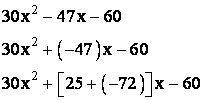A Note on Factoring
Consider the trinomial ![]() and let’s use both methods for
factoring it.
and let’s use both methods for
factoring it.
First, look at the “ac” or “grouping” method for factoring.
This method gets its name from the fact that we have defined the standard form
for a general quadratic trinomial to be ![]() and we will be using the leading
coefficient and constant term to create a product to factor; then we will use
those factors to create a polynomial we can factor by grouping. For the trinomial
above,
and we will be using the leading
coefficient and constant term to create a product to factor; then we will use
those factors to create a polynomial we can factor by grouping. For the trinomial
above, ![]() so
we need to list the factors of
so
we need to list the factors of ![]() .
.
![]()
![]()
![]()

![]()
![]()


I have listed the sum of the factors in each case because
what we are seeking is the pair of factors that add to give us ![]() in the trinomial
we are attempting to factor. In this case, we have
in the trinomial
we are attempting to factor. In this case, we have ![]() so the pair of factors that
we want is
so the pair of factors that
we want is ![]() and
and
![]() .
.
Since ![]() , we can substitute in our original
trinomial as follows:
, we can substitute in our original
trinomial as follows:

Applying the Distributive Property, we now have
![]()
Now we want to factor this four-term expression by grouping the terms 2 and 2 like this:
![]()
For emphasis, I want to rewrite this using only addition.
![]()
Now, factor the Greatest Common Factor from each pair.
![]()
Noting that ![]() is common to both of these terms, we
now factor it out.
is common to both of these terms, we
now factor it out.
![]()
Simplifying, we obtain our final result.
![]()
There are several things to point out about what we have done which can aid us in doing this kind of problem:
1) We could have written ![]() instead of
instead of ![]() . In that case, our steps
would have remained the same, but each would have “looked” slightly different.
Our final result would have been
. In that case, our steps
would have remained the same, but each would have “looked” slightly different.
Our final result would have been ![]() which is equivalent to what we have
above because of the Commutative Property of Multiplication.
which is equivalent to what we have
above because of the Commutative Property of Multiplication.
2) Although we initially listed all 36 possible factors for
![]() , we
could have cut that number in half by noting that
, we
could have cut that number in half by noting that ![]() implies that the factor with the
larger absolute value must be the one that is negative.
implies that the factor with the
larger absolute value must be the one that is negative.
3) If the product ac is positive, there will still be two cases for each pair of factors – one case will have both factors positive and the other case will have both factors negative. Again, we can use the sign on b to cut the number of pairs we have to consider in half.
4) A major advantage of this method, although there is still some trial and error involved, is that we can use the same method both for the case where the leading coefficient is 1 and where the leading coefficient is not 1. Here is a quick example of how it would work when the leading coefficient is 1:
[Note that ![]() when the leading
coefficient is 1.]
when the leading
coefficient is 1.]
Consider the trinomial ![]()
![]()
![]()
![]()

![]()
![]()
![]()

Since ![]() , we proceed as follows:
, we proceed as follows:

I leave it to you to supply the reasons for each step.
Now let’s return to our original trinomial ![]() and look at what
is involved if we are to use strictly trial and error.
and look at what
is involved if we are to use strictly trial and error.
The factors of ![]() are The
factors of
are The
factors of ![]() are
are


[Note: It is not necessary to
consider the case where both factors of ![]() are negative since we can simply
factor
are negative since we can simply
factor ![]() out
of both factors and reduce it to the case where both factors of
out
of both factors and reduce it to the case where both factors of ![]() are positive.]
are positive.]
Since we must consider all possible pairings, there will be ![]() separate cases to
be listed and checked. (Checking is by multiplying out the proposed factors!)
To get the idea, I will list only the first several cases.
separate cases to
be listed and checked. (Checking is by multiplying out the proposed factors!)
To get the idea, I will list only the first several cases.


















and so on until all 96 cases are listed! There have been a number of techniques developed over the years to try to make this process more efficient, but each requires that a significant amount of the work be done in your head to avoid so much writing. None of these trial and error techniques is very satisfactory when compared with the efficiency of the “ac” or “grouping” method.